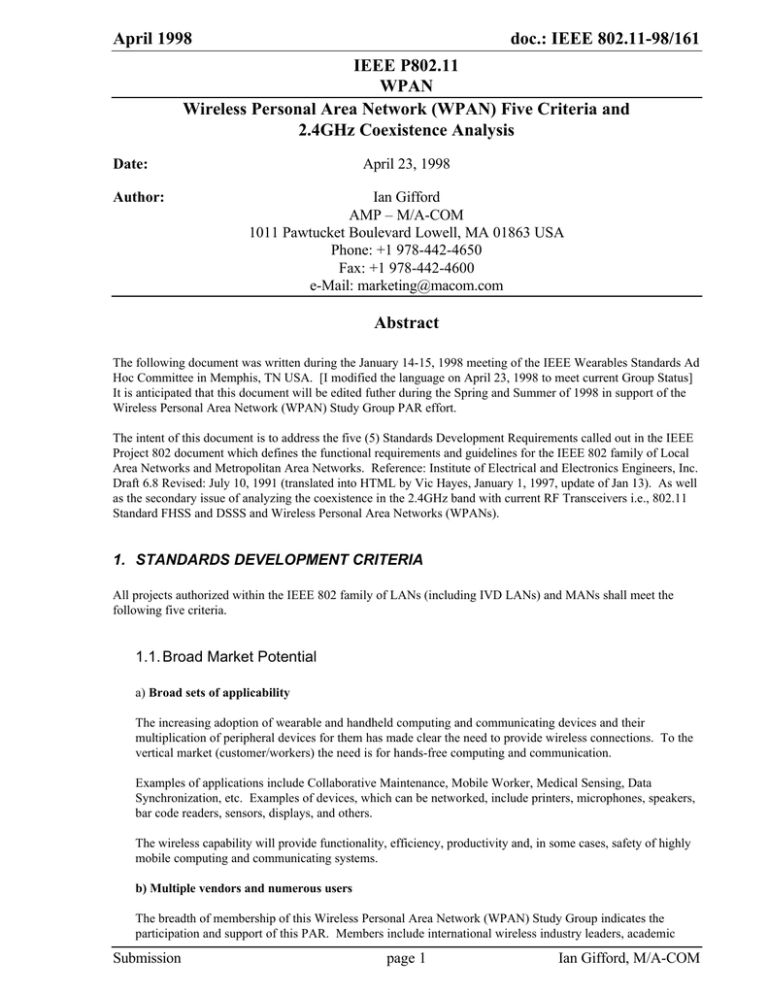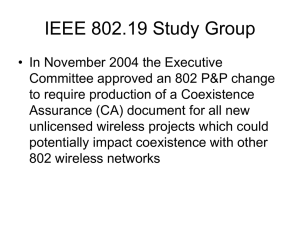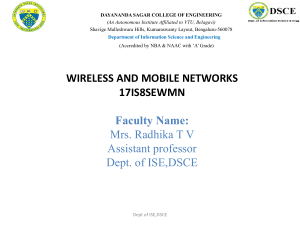April 1998 doc.: IEEE 802.11-98/161 IEEE P802.11 WPAN Wireless
advertisement

April 1998 doc.: IEEE 802.11-98/161 IEEE P802.11 WPAN Wireless Personal Area Network (WPAN) Five Criteria and 2.4GHz Coexistence Analysis Date: Author: April 23, 1998 Ian Gifford AMP – M/A-COM 1011 Pawtucket Boulevard Lowell, MA 01863 USA Phone: +1 978-442-4650 Fax: +1 978-442-4600 e-Mail: marketing@macom.com Abstract The following document was written during the January 14-15, 1998 meeting of the IEEE Wearables Standards Ad Hoc Committee in Memphis, TN USA. [I modified the language on April 23, 1998 to meet current Group Status] It is anticipated that this document will be edited futher during the Spring and Summer of 1998 in support of the Wireless Personal Area Network (WPAN) Study Group PAR effort. The intent of this document is to address the five (5) Standards Development Requirements called out in the IEEE Project 802 document which defines the functional requirements and guidelines for the IEEE 802 family of Local Area Networks and Metropolitan Area Networks. Reference: Institute of Electrical and Electronics Engineers, Inc. Draft 6.8 Revised: July 10, 1991 (translated into HTML by Vic Hayes, January 1, 1997, update of Jan 13). As well as the secondary issue of analyzing the coexistence in the 2.4GHz band with current RF Transceivers i.e., 802.11 Standard FHSS and DSSS and Wireless Personal Area Networks (WPANs). 1. STANDARDS DEVELOPMENT CRITERIA All projects authorized within the IEEE 802 family of LANs (including IVD LANs) and MANs shall meet the following five criteria. 1.1. Broad Market Potential a) Broad sets of applicability The increasing adoption of wearable and handheld computing and communicating devices and their multiplication of peripheral devices for them has made clear the need to provide wireless connections. To the vertical market (customer/workers) the need is for hands-free computing and communication. Examples of applications include Collaborative Maintenance, Mobile Worker, Medical Sensing, Data Synchronization, etc. Examples of devices, which can be networked, include printers, microphones, speakers, bar code readers, sensors, displays, and others. The wireless capability will provide functionality, efficiency, productivity and, in some cases, safety of highly mobile computing and communicating systems. b) Multiple vendors and numerous users The breadth of membership of this Wireless Personal Area Network (WPAN) Study Group indicates the participation and support of this PAR. Members include international wireless industry leaders, academic Submission page 1 Ian Gifford, M/A-COM April 1998 doc.: IEEE 802.11-98/161 researchers, semiconductor manufacturers, system integrators, and corporate end users. More than 30 companies were represented in participation of this PAR. The target user base will be large as indicated by the growing demand for PDAs, HPCs, etc. c) Balanced costs (LAN versus attached stations) Wireless Personal Area Network (WPAN) connectivity costs will be a small percentage of the target devices e.g., printers, microphones, speakers, bar code readers, sensors, displays, and others. 1.2. Compatibility IEEE 802 defines a family of standards. All standards shall be in conformance with IEEE 802.1 Architecture, Management and Interworking. All LLC and MAC standards shall be compatible with ISO 10039, MAC Service Definition1, at the LLC/MAC boundary. Within the LLC Working Group there shall be one LLC standard, including one or more LLC protocols with a common LLC/MAC interface. Within a MAC Working Group there shall be one MAC standard and one or more Physical Layer standards with a common MAC/Physical layer interface. Each standard in the IEEE 802 family of standards shall include a definition of managed objects, which are compatible with OSI systems management standards. Note: This requirement is subject to final resolution of corrections and revision to current ISO 10039, currently inconsistent with ISO 8802 series standards. The MAC (Medium Access Control) Layer of the Wireless Personal Area Network (WPAN) Standard will be compatible with the IEEE 802 requirements for architecture, management, and inter-networking. 1.3. Distinct Identity a) Substantially different from other IEEE 802 standards. The Wireless Personal Area Network (WPAN) domain is complimentary as well as provides for an extension to the 802 Projects range from 0 meters to 10 meters. The 802.11 Standard does not provide balanced cost for this class of devices. The 802.11 Standard can not meet the power consumption envelope of this class of devices. The 802.11 Standard can not meet the relative size requirements for this class of devices. The 802.11 Standard requires a 1Mbit minimum data rate where these classes of devices may not require 1Mbit. b) One unique solution per problem (not two solutions to a problem). The Wireless Personal Area Network (WPAN) Standard will consist of one Medium Access Control and Physical Layer. We are unaware of any existing standard that will facilitate this class of devices. c) Easy for the document reader to select the relevant specification. The proposed Wireless Personal Area Network (WPAN) Standard distinct document with clearly distinguishable applications. 1.4. Technical Feasibility a) Demonstrated system feasibility Submission page 2 Ian Gifford, M/A-COM April 1998 doc.: IEEE 802.11-98/161 There are several research activities that lead us to believe that the power management, network frequency management, and network management services issues are feasible and can be resolved. We have the ability to trade-off range and bandwidth to meet overall system objectives. b) Proven technology, reasonable testing There are examples of technology that exist today in the form of prototypes. c) Confidence in reliability The air interface protocol will be designed to meet commercial reliability standards. The data from existing products and prototypes representing the candidate approaches provides confidence in the reliability of the proposed solutions. 1.5. Economic Feasibility a) Known cost factors, reliable data The fundamental radio architecture (RF/IF) of the candidate approaches is leveraging off P802.11. Reduced performance requirement results in a substantially reduced cost of implementation. Also the use of 2.4GHz ISM will flow in the wake of P802.11 standard release and RFIC product development thus providing a low cost source of supply. b) Reasonable cost for performance Based of research results and prototype solutions, implementation estimates meet requirements. c) Consideration of installation costs The plug n’ play design insertion substantially reduces the user training, and network management. The fact that devices are embedded into the devices minimizes installation costs. 2. Analysis of WPAN Coexistence in the 2.4GHz band TBD Submission page 3 Ian Gifford, M/A-COM




